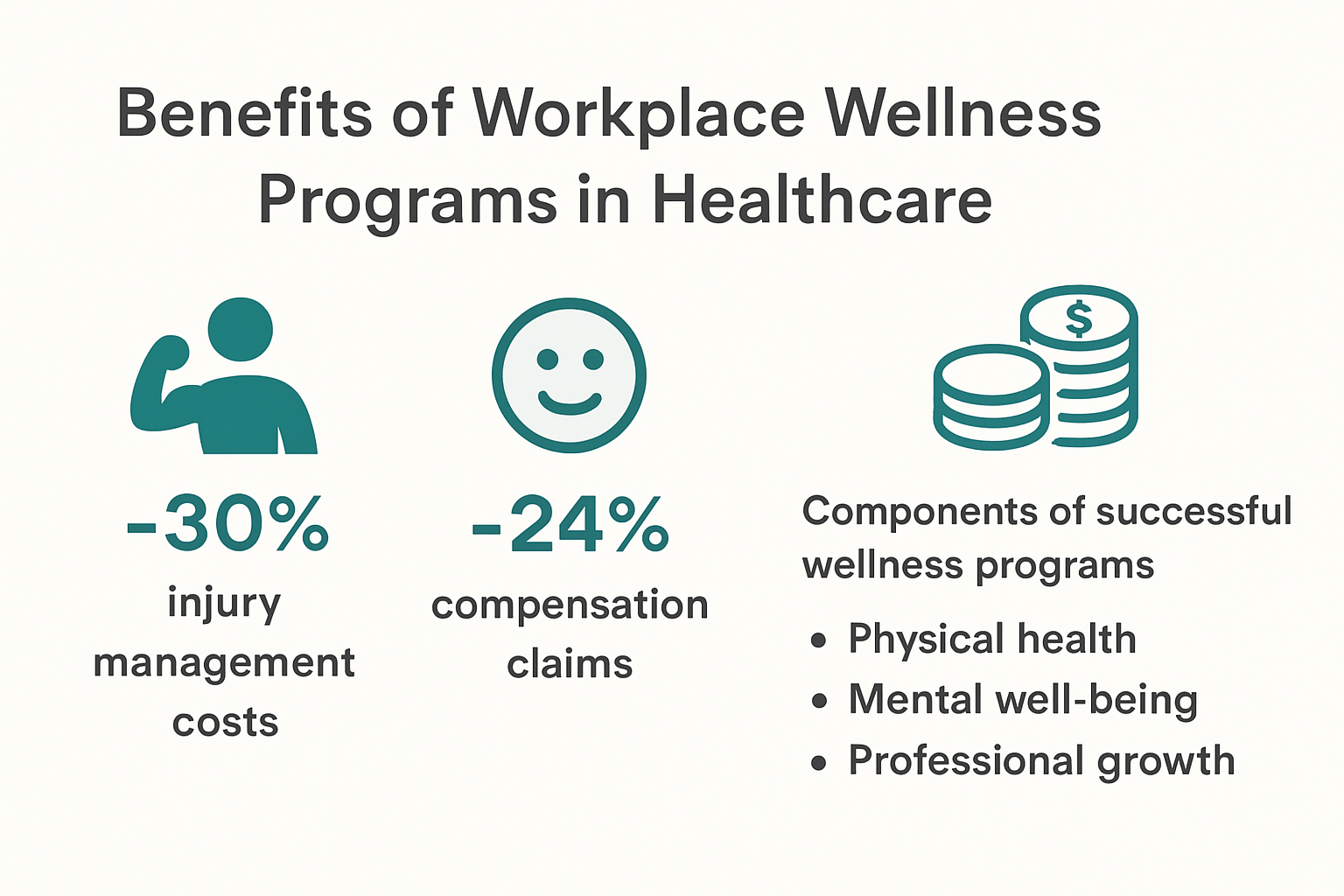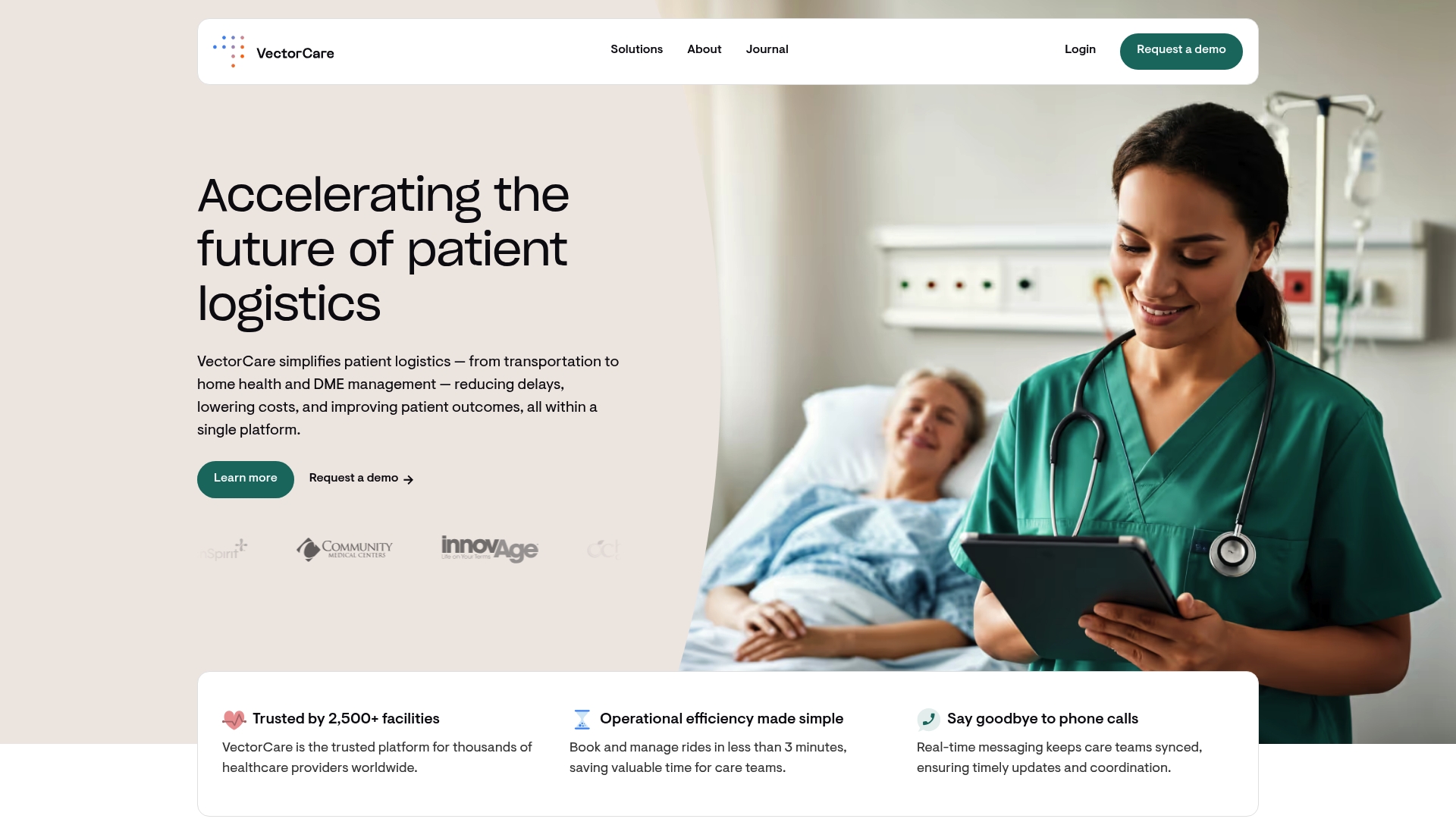Workplace Wellness Programs: Boosting Health in Healthcare Settings

Hospitals and clinics face sky-high stress and long hours, and workplace wellness programs are quickly becoming a must-have in healthcare. Hold on though. While most people think wellness programs are just about gym memberships or free fruit in the break room, the real impact is much bigger. Some organizations have seen a 56 percent drop in injury management costs and a 46 percent decrease in workplace compensation claims by getting wellness right. This flips the script on what workplace wellness can actually do for both employees and the bottom line.
Table of Contents
- Key Benefits Of Workplace Wellness Programs
- Essential Elements For Successful Implementation
- Best Practices Tailored For Healthcare Organizations
- Measuring Impact And Ensuring Long-Term Success
Quick Summary
| Takeaway | Explanation |
|---|---|
| Implement wellness programs for health benefits. | Workplace wellness programs enhance physical and mental health for employees, reducing stress and absenteeism. |
| Invest in employee well-being for financial gains. | Implementing wellness initiatives can lower healthcare costs and increase employee retention and productivity. |
| Create a supportive organizational culture. | Leadership should prioritize employee health, fostering an environment that integrates wellness into the core strategy. |
| Adopt tailored programs for healthcare settings. | Design interventions that address the unique challenges faced by healthcare professionals, ensuring effective participation. |
| Regularly evaluate and adapt wellness initiatives. | Continuous assessment is crucial to refine wellness programs based on employee feedback and performance metrics. |
Key Benefits of Workplace Wellness Programs
Healthcare organizations face unprecedented challenges in maintaining staff well-being and organizational performance. Workplace wellness programs have emerged as a critical strategy for addressing these complex issues, offering comprehensive benefits that extend far beyond traditional health interventions.

Physical and Mental Health Improvements
Workplace wellness programs deliver substantial improvements in both physical and mental health outcomes for healthcare professionals. Research published in the International Journal of Environmental Research and Public Health demonstrates that these programs can significantly decrease absenteeism and promote healthier lifestyle behaviors. Healthcare workers experience reduced stress levels, increased physical activity, and enhanced nutritional choices through targeted wellness initiatives.
These programs typically incorporate comprehensive health screenings, fitness challenges, nutrition counseling, and mental health support. By providing structured interventions, organizations create environments that prioritize employee well-being. The holistic approach addresses multiple dimensions of health, recognizing that healthcare professionals require specialized support due to their high-stress work environments.
Economic and Organizational Advantages
According to a systematic review in the Journal of Occupational and Environmental Medicine, workplace wellness programs generate significant economic benefits for healthcare organizations. These programs are directly linked to measurable improvements in employee retention, reduced healthcare costs, and enhanced overall productivity.
Organizations implementing robust wellness strategies observe tangible outcomes such as decreased burnout rates, improved job satisfaction, and lower healthcare expenditures. By investing in employee health, institutions create positive feedback loops that benefit both staff members and the broader healthcare ecosystem. The financial implications are substantial, with potential savings in recruitment, training, and healthcare-related expenses.
Long-Term Professional Development
Beyond immediate health benefits, workplace wellness programs contribute to long-term professional development and organizational resilience. Healthcare professionals who participate in these programs often report increased engagement, better work-life balance, and more robust coping mechanisms for handling high-stress clinical environments.
Wellness initiatives frequently include professional development components like stress management workshops, leadership training, and personal growth seminars. These elements help healthcare workers develop comprehensive skill sets that extend beyond clinical competencies. Learn more about integrated professional support strategies that complement workplace wellness approaches.

By creating comprehensive support systems, healthcare organizations demonstrate a commitment to their most valuable asset: their employees. Workplace wellness programs represent more than just health interventions; they are strategic investments in human capital, organizational culture, and sustainable healthcare delivery.
Essential Elements for Successful Implementation
Successful workplace wellness programs require strategic planning, comprehensive design, and thoughtful execution. Healthcare organizations must approach implementation with a holistic and systematic methodology that addresses multiple dimensions of employee well-being and organizational culture.
Organizational Culture and Leadership Commitment
According to the CDC’s National Institute for Occupational Safety and Health, developing an effective workplace wellness program begins with establishing a strong organizational culture that prioritizes employee health. Leadership must demonstrate genuine commitment by actively participating in and visibly supporting wellness initiatives. This means moving beyond superficial endorsements to create meaningful cultural transformations that integrate wellness into the core organizational strategy.
Key leadership responsibilities include allocating adequate resources, removing systemic barriers to employee well-being, and creating an environment that normalizes conversations about mental and physical health. Organizations must develop clear principles that communicate the importance of wellness, not just as a performance metric but as a fundamental aspect of employee care.
Comprehensive Program Design and Implementation
The U.S. Department of Health and Human Services emphasizes the critical importance of tailoring wellness programs to specific workplace needs. Healthcare settings require nuanced approaches that recognize the unique stressors and challenges faced by medical professionals. Programs should include a diverse range of interventions such as mental health support, stress management workshops, physical fitness opportunities, nutritional counseling, and professional development resources.
Effective implementation involves engaging employees at multiple levels, creating opportunities for meaningful participation, and developing incentive structures that motivate sustained engagement. This might include offering flexible scheduling for wellness activities, providing confidential support services, and creating clear pathways for feedback and continuous improvement. Explore strategies for integrated professional support that complement comprehensive wellness approaches.
Continuous Evaluation and Adaptation
Successful workplace wellness programs are not static but dynamic systems that evolve based on ongoing assessment and employee feedback. Organizations must establish robust measurement frameworks that track both quantitative metrics like healthcare cost reductions and absenteeism rates, and qualitative indicators such as employee satisfaction and perceived well-being.
Regular program evaluations should include comprehensive data collection, anonymous surveys, focus groups, and individual interviews. These insights enable organizations to identify strengths, address emerging challenges, and continuously refine their wellness strategies. The goal is to create an adaptive system that responds to changing workforce needs, technological advancements, and emerging best practices in employee health and wellness.
By implementing a holistic, data-driven approach to workplace wellness, healthcare organizations can create sustainable programs that support employee health, enhance organizational performance, and ultimately improve patient care quality.
Best Practices Tailored for Healthcare Organizations
Healthcare organizations require specialized approaches to workplace wellness that address the unique challenges and high-stress environments inherent in medical professions. Developing effective wellness strategies demands a nuanced understanding of healthcare workers’ specific needs and organizational dynamics.
Comprehensive Organizational Support Framework
According to the U.S. Surgeon General’s Framework for Workplace Mental Health and Well-Being, successful wellness programs must encompass five critical essentials: protection from harm, connection and community, work-life harmony, mattering at work, and opportunity for growth. Healthcare organizations must create holistic support systems that go beyond traditional health interventions.
To summarize the five critical essentials for successful workplace wellness programs in healthcare organizations, the following table outlines each essential with a brief description based on the article content.
| Essential | Description |
|---|---|
| Protection from harm | Ensuring physical and psychological safety for employees |
| Connection and community | Fostering supportive relationships and workplace belonging |
| Work-life harmony | Promoting balance between professional and personal life |
| Mattering at work | Ensuring employees feel valued and significant |
| Opportunity for growth | Providing avenues for professional and personal development |
This approach requires establishing dedicated wellness committees, implementing confidential support mechanisms, and developing comprehensive resources that address both physical and mental health challenges. Organizations should focus on creating safe reporting systems, promoting psychological safety, and ensuring that employees feel valued and supported throughout their professional journey.
Strategic Program Design and Implementation
Research published in the Mayo Clinic Proceedings emphasizes the critical role of leadership in designing effective wellness programs. Healthcare leaders must actively demonstrate commitment through visible participation, resource allocation, and cultural transformation. This involves creating tailored interventions that recognize the unique stressors faced by medical professionals.
Key strategies include developing specialized stress management workshops, providing flexible scheduling options, offering confidential counseling services, and creating clear pathways for professional development. Learn more about technology-driven approaches to empowering healthcare professionals that complement comprehensive wellness initiatives.
Continuous Evaluation and Adaptive Strategies
The CDC’s Workplace Health Model highlights the importance of creating dynamic, responsive wellness programs. Healthcare organizations must establish robust measurement frameworks that capture both quantitative and qualitative indicators of employee well-being.
This requires implementing regular assessment mechanisms such as anonymous surveys, focus groups, and comprehensive data analysis. Programs should be flexible enough to adapt to emerging challenges, technological advancements, and changing workforce needs. The goal is to create a continuous improvement cycle that demonstrates a genuine commitment to employee health and organizational resilience.
Successful workplace wellness programs in healthcare settings are more than just intervention strategies. They represent a fundamental reimagining of organizational culture, prioritizing employee well-being as a critical component of high-quality patient care and institutional excellence. By adopting a holistic, data-driven approach, healthcare organizations can create sustainable support systems that nurture their most valuable asset: their dedicated healthcare professionals.
Measuring Impact and Ensuring Long-Term Success
Measuring the effectiveness of workplace wellness programs is crucial for healthcare organizations seeking to validate their investments and ensure sustained employee well-being. A strategic approach to impact assessment requires comprehensive, multifaceted evaluation methods that go beyond traditional metrics.
Comprehensive Performance Metrics
A report to Congress on workplace wellness programs revealed that while 60% of employers observed reduced healthcare costs and approximately 80% reported decreased absenteeism, less than half systematically evaluated their programs. This highlights the critical need for robust, data-driven assessment strategies.
Healthcare organizations must develop holistic measurement frameworks that capture both quantitative and qualitative indicators. Key performance metrics should include healthcare cost reductions, absenteeism rates, employee engagement levels, productivity improvements, and subjective measures of employee well-being. Organizations need to establish baseline measurements and track longitudinal data to understand the true impact of their wellness initiatives.
Advanced Evaluation Methodologies
Research from the RAND Corporation suggests that continuous program participation over extended periods is associated with potential healthcare cost reductions. This underscores the importance of developing sophisticated evaluation methodologies that can capture nuanced long-term impacts.
Effective evaluation strategies should incorporate multiple data collection methods, including anonymous surveys, focus groups, individual interviews, and comprehensive statistical analyses. Learn more about technology-driven approaches to measuring organizational outcomes that can enhance program assessment capabilities.
Sustainability and Continuous Improvement
A study in a Melbourne surgical hospital demonstrated remarkable outcomes from a well-designed workplace health management program, including a 56% reduction in injury management costs and a 46% decrease in compensation injury claims. These findings highlight the potential for significant organizational benefits when wellness programs are systematically implemented and evaluated.
Sustainability requires a commitment to continuous improvement. Healthcare organizations must create adaptive frameworks that allow for regular program refinement based on emerging data, changing workforce needs, and evolving best practices. This involves establishing cross-functional wellness committees, maintaining open communication channels, and developing flexible intervention strategies.
Successful long-term workplace wellness programs are not static initiatives but dynamic, responsive systems that evolve with organizational needs. By implementing comprehensive measurement strategies, healthcare organizations can transform wellness from a peripheral activity to a core component of their operational excellence. The ultimate goal is to create a workplace culture that genuinely prioritizes employee well-being, recognizing it as a critical driver of individual and organizational performance.
Frequently Asked Questions
What are the key benefits of workplace wellness programs for healthcare professionals?
Workplace wellness programs for healthcare professionals can lead to improvements in physical and mental health, reduced stress levels, enhanced employee engagement, better work-life balance, lower healthcare costs, and increased job satisfaction.
How do workplace wellness programs impact organizational performance?
Implementing effective workplace wellness programs can enhance organizational performance by reducing absenteeism, improving employee retention, and increasing overall productivity, resulting in significant economic advantages for healthcare organizations.
What essential elements are needed for successful implementation of wellness programs?
Successful wellness programs require a strong organizational culture, leadership commitment, comprehensive program design tailored to employee needs, and continuous evaluation and adaptation based on employee feedback and performance metrics.
How can healthcare organizations measure the success of their wellness initiatives?
Healthcare organizations can measure the success of their wellness initiatives using comprehensive performance metrics that include healthcare cost reductions, absenteeism rates, employee engagement levels, and qualitative measures of employee well-being.
Empower Your Team’s Wellness With Smarter Healthcare Logistics
Healthcare organizations know that daily stress, burnout, and inefficiencies can undermine even the best wellness programs. The article above highlights how reducing administrative burden and boosting employee well-being are crucial for successful workplace wellness, yet many hospitals and clinics still struggle with fragmented processes and delayed support. Disorganized patient logistics and communication gaps make it harder for healthcare staff to focus on both their own health and quality patient care.

VectorCare offers a proven path to a healthier workplace. By automating patient logistics and streamlining vital operations, VectorCare removes manual headaches like transportation scheduling and equipment delivery, freeing your workforce to prioritize what matters most. Imagine a single digital platform where scheduling is simplified, communication is secure, and every detail is transparent in real time. Start transforming your workforce experience and enable better wellness for your staff and patients. See how you can optimize your daily operations at VectorCare, or explore how technology can empower healthcare professionals for deeper insights. Now is the best time to build a culture of wellness while improving every step of care delivery.



